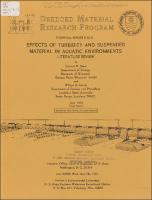Please use this identifier to cite or link to this item:
https://hdl.handle.net/11681/47244| Title: | Effects of turbidity and suspended material in aquatic environments : literature review |
| Authors: | Stern, Edward M. Stickle, William B., 1943- |
| Keywords: | Turbidity Suspended sediments Dredging Dredging spoil Dredged material |
| Publisher: | U.S. Army Engineer Waterways Experiment Station |
| Series/Report no.: | Technical Report (Dredged Material Research Program (U.S.)) ; no. D-78-21 |
| Abstract: | This literature review of the effects of turbidity and suspended material in aquatic environments covers the following subjects: definitions, units of measure, and methods of measurement; origins; and effects in aquatic environments. Turbidity, regardless of the multiplicity of definitions, units of measure, and methods of measurement, is an expression of the optical properties of water that cause light to be scattered and absorbed rather than transmitted in a straight line. Turbidity is not the same as siltatlon, although the terms have been used synonymously in the past. The various units of measure include the Jackson Turbidity Unit (JTU), Formazin Turbidity Unit (FTU), and Nephelometric Turbidity Unit (NTU). The methods of measuring percent transmission or the weight per volume concentration of suspended particulates are based on either gravimetric or optical techniques. Turbidity and suspended material in the aquatic environment are the result of both natural processes and the activities of man. Land erosion.is the major source, with agricultural activity contributing the bulk of the material. Additional sources include the resuspension of bottom sediments, dredging and the disposal of dredged material and turbidity maxima and currents. The environmental effects of turbidity and suspended material are both beneficial and detrimental. Water quality is partially determined by a number of reactions with suspended material that function in the adsorption, transportation, and desorption of heavy and trace metals, pesticides, and nutrients. Turbidity and suspended material may reduce photosynthetic activity by interference with light penetration. However, primary production, can also be stimulated through the addition of nutrients associated with particulates. Turbidity and suspended material variously affect aquatic animals. Among, coelenterates, turbidity, and suspended material are usually detrimental to coral reefs through the reduction of feeding activities, and the reduction of light available to the symbiotic coralline algae. Bivalve molluscs (clams, oysters, mussels), as filter feeders, play an important role in reducing turbidity in natural systems by removing suspended materials from the water column. Most studies on adult estuarine and marine bivalves have indicated that, except for individuals directly buried by the disposal operation, the mortality rate among populations adjacent to dredging and disposal areas is low. By contrast, laboratory studies indicate that the percentage of normally developing eggs and larvae usually decreases as the concentration of suspended solids increases in the range of concentrations normally resulting from dredging and disposal. Laboratory studies of several species of crustaceans (crabs, lobsters, shrimp) and fishes have indicated that suspended solids, temperature, and dissolved oxygen can interact in a highly complex, nonadditive manner to Influence survival time. Adult fishes as a group are more sensitive to suspended solids than most invertebrates. However, in most studies of the effects of dredging and disposal operations on fishes, patterns of seasonal occurrence, abundance, and species diversity generally remained similar to the controls. Suspended solids can be responsible for a delay of several hours in the hatching time of fish eggs. The literature indicates that turbidity and suspended solids conditions typically created by most dredging and disposal operations are of short duration and are unlikely to produce severe and irreversible ecological effects: possible exceptions to this generalization are coral reefs and other communities especially sensitive to turbidity. Any possible effects of turbidity and suspended material in aquatic environments may be further minimized by careful selection of disposal sites; keying operations to seasonal cycles in biological activity; and special consideration of areas that serve as nursery grounds. |
| Description: | Technical Report |
| Gov't Doc #: | Technical Report D-78-21 |
| Rights: | Approved for Public Release; Distribution is Unlimited |
| URI: | https://hdl.handle.net/11681/47244 |
| Appears in Collections: | Technical Report |
Files in This Item:
| File | Description | Size | Format | |
|---|---|---|---|---|
| Technical Report D-78-21.pdf | 7.78 MB | Adobe PDF |  View/Open |